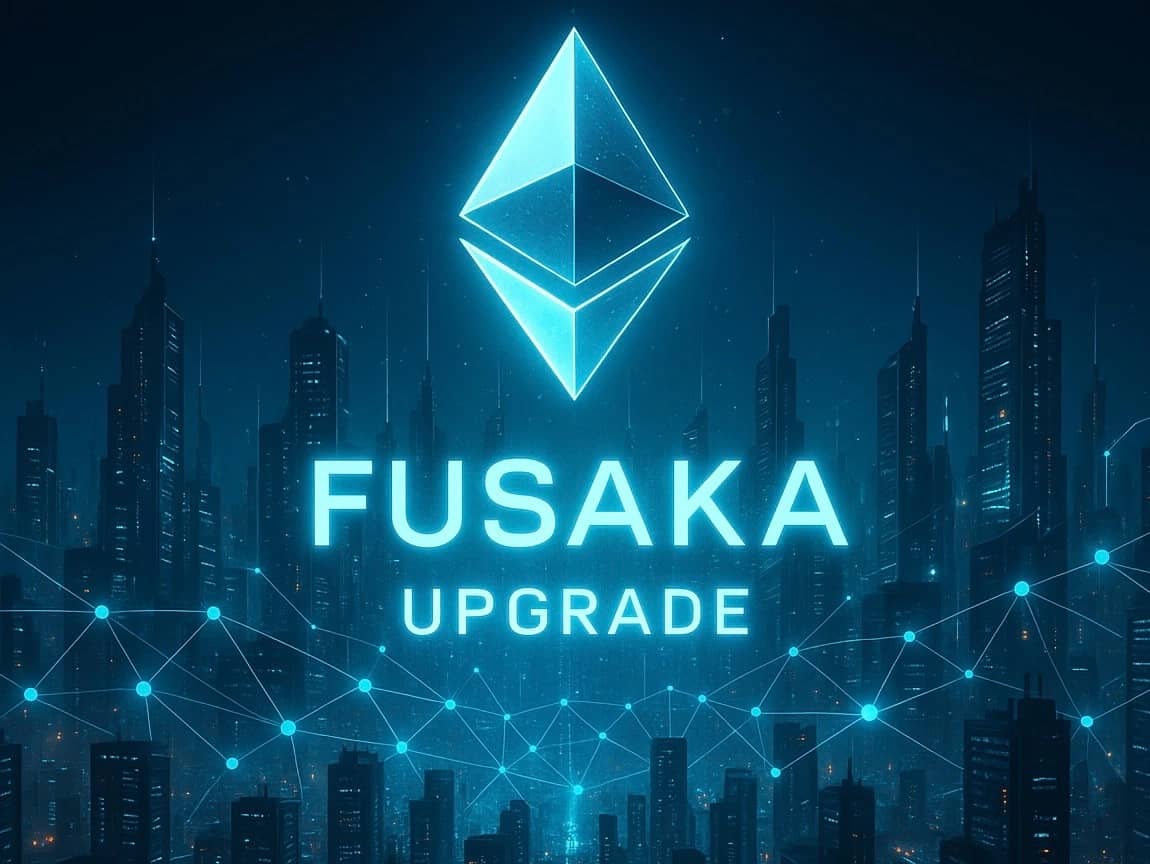订阅 wiki
Share wiki
Bookmark
Ethereum Fusaka Upgrade
Ethereum Fusaka Upgrade
Fusaka 是一个即将到来的 硬分叉 和 以太坊 区块链 的重大网络升级,暂定于 2025 年 11 月发布。此次升级旨在增强网络的效率、可扩展性和安全性,并在先前硬分叉(如 Pectra)中引入的改进基础上构建。 [1]
概述
Fusaka 硬分叉代表了以太坊持续发展路线图中的下一个重要步骤,预计在2025年5月的Pectra升级后约六个月进行。其主要目标是通过关注后端增强而非面向用户的功能,来提高以太坊网络的整体性能和弹性。此次升级捆绑了一系列以太坊改进提案(EIP),旨在优化与可扩展性、节点健康和效率相关的核心协议功能,同时保持现有智能合约不变。 [20] [21]
技术
预计Fusaka升级将包含11个以太坊改进提案(EIP),旨在增强网络的功能。其中一项关键提案是EIP-7825,旨在增强网络抵御恶意交易垃圾邮件的弹性,同时也有助于提高整体可扩展性。 [20] [3]
然而,并非所有最初考虑的提案都将成为Fusaka版本的一部分。EIP-7907旨在将合约代码大小限制翻倍并引入gas计量,但已被排除,以简化测试过程并避免潜在的延迟。同样,备受争议的EVM对象格式(EOF)升级,该升级提议彻底改革以太坊虚拟机(EVM)以简化智能合约开发,但由于技术上的不确定性以及社区对其复杂性和影响的反对,已正式从Fusaka中移除。移除EOF的决定是为了优先考虑其他关键功能,如PeerDAS,该功能侧重于增强以太坊's的可扩展性和数据可用性,并确保升级的时间表不会受到影响。 [20] [4] [5] [6]
Fusaka中包含的一项重要的拟议变更包括增加以太坊 gas限制。EIP-7935为增加gas限制奠定了基础,最初的目标约为4500万,长期目标是扩展到1.5亿。此调整旨在提高网络吞吐量并支持更复杂的操作,从而可能降低交易成本并提高可扩展性。 [1] [20]
关键的以太坊改进提案(EIP)
Fusaka捆绑了11个基础设施级别的EIP,这些EIP在不破坏现有合约的情况下,改进了可扩展性,提高了效率并加强了网络。关键提案包括:
- EIP-7594 (PeerDAS): 一项重大的可扩展性增强,引入了对等数据可用性抽样。这允许节点验证数据可用性,而无需下载整个数据blobs,从而减轻了节点的负载并提高了rollup性能。
- EIP-7825 (垃圾邮件抵抗检查): 通过限制单个交易的gas限制来防止恶意交易垃圾邮件,从而帮助节点在高需求下保持稳定。
- EIP-7823 (MODEXP 参数限制): 通过限制用于模幂运算的MODEXP预编译的输入大小,增强以太坊对拒绝服务(DoS)攻击的抵抗力。
- EIP-7883 (MODEXP Gas 成本调整): 调整繁重的密码学操作的gas定价,以更好地反映其计算成本,从而提高网络效率。
- EIP-7892 (仅 Blob 参数的分叉): 创建一个框架,用于对blob参数进行轻量级的未来调整,而无需完整的硬fork,从而简化了未来的升级。
- EIP-7917 (确定性提议者前瞻): 预先计算block提议者以简化验证过程,这对于rollup和staking操作特别有用。
- EIP-7918 (Blob 基本费用边界): 将blob费用与执行成本联系起来,为数据blobs创建更公平,更可预测的定价机制。
- EIP-7934 (RLP 执行区块大小限制): 对编码区块的大小施加上限,以限制网络膨胀并支持可扩展性,而不会破坏兼容性。
- EIP-7935 (默认区块 Gas 限制): 概述了增加block gas限制的计划,从大约4500万开始,并扩展到1.5亿,以使每个block能够进行更多交易。
- EIP-7939 (CLZ Opcode): 向EVM添加“计算前导零”指令,该指令对于密码学,压缩和其他位级优化很有用。
- EIP-7951 (secp256r1 预编译): 引入对P-256椭圆曲线的本机支持,这是Web2安全中广泛使用的标准,使Ethereum更接近已建立的安全标准和钱包。
这组EIP在2025年8月1日的EIP冻结后最终确定,以确保集中且可测试的升级。 [20] [21]
开发和时间表
Fusaka 硬分叉 的准备工作一直在积极进行中,遵循积极但审慎的开发计划。该过程涉及多个开发网络 (devnet) 来测试和改进包含的 EIP。在最初的 devnet 之后,Fusaka Devnet 2 于 2025 年 6 月 27 日启动,作为“漏洞搜寻”以识别问题,随后是 Devnet 3,用于测试“顺利通过”的场景。最终的 devnet 于 2025 年 7 月 23 日启动,计划随后进行公共测试网。 [1] [21]
尽管时间安排雄心勃勃,但 以太坊 社区的一些成员对能否达到拟议的发布日期表示担忧。 以太坊 协议支持成员 Nixo 指出,在 Devconnect 之前发布升级版本的时间非常紧张,强调需要在短时间内发布客户端版本。开发路线图包括成功的测试网、漏洞赏金计划和压力测试的计划,预计这些将是网络为全面部署做好准备的关键指标。 [9] [7]
测试网和主网启动
Fusaka升级的测试网部署计划包括9月29日的Holesky,随后是10月13日的Sepolia和10月27日的Hoodi。开发者计划在11月5日至12日之间启动主网,并将其锁定在特定的区块高度,该高度恰好在11月17日至22日在阿根廷布宜诺斯艾利斯举行的Devconnect活动之前。主网激活只有在所有测试网成功升级并且最终开发网络的分析确认网络运行正常后才会进行。 [20] [8] [17]
安全审计竞赛
为了在主网启动前加强安全性,以太坊 基金会宣布了一项针对Fusaka升级的200万美元审计竞赛。 [17] 该竞赛由Gnosis和Lido共同赞助,并在Sherlock平台上举办,于2025年9月15日开始,持续四周至10月13日。 [22] [18] Gnosis贡献了10万美元,Lido贡献了2.5万美元作为奖金池。该竞赛邀请安全研究人员识别升级代码库中的漏洞,第一周有效发现的积分乘以2,第二周乘以1.5,以激励早期发现。 [22] 然而,一些观察员质疑比赛的时机,指出开发人员仍在积极识别开发网络上的错误。 [17]
对用户和开发者的影响
对于开发者来说,Fusaka 被设计为非破坏性的升级。其中包含的任何 EIP 都不打算破坏现有的智能合约或接口,从而确保去中心化应用程序 (dApp) 和客户端保持完全兼容。构建者的主要好处来自增加的 gas 限制,这允许在单个 区块 内进行更多交易和更复杂的操作,以及来自 PeerDAS 的性能改进,这将特别有利于 rollups。 [20]
对于日常用户来说,Fusaka 的改进将是微妙但明显的。预计此次升级将导致更稳定的 gas 费用和更顺畅的交易 流程,尤其是在网络流量高峰期。通过专注于 以太坊 的核心引擎,Fusaka 旨在提供更稳定和高效的体验,而无需用户采取任何行动。 [20]
未来升级
继Fusaka之后,人们的注意力已经转向下一个以太坊升级,代号为Glamsterdam。Glamsterdam的拟议功能预计将在8月1日的AllCoreDevs – Execution会议上确认。以太坊核心开发者Barnabé Monnot提出了一项值得注意的Glamsterdam提案,建议将以太坊的区块时间从12秒减半至6秒。如果被采纳,这一变化可能会显著提高去中心化应用程序(dApps)的性能和用户体验,目前计划将其纳入预计在2026年进行的Glamsterdam升级中。 [1] [10] [2]
监管讨论
在技术发展的同时,美国证券交易委员会(SEC)最近与主要的区块链行业利益相关者进行了讨论,包括来自以太坊相关组织的代表,如ERC-3643协会、Chainlink Labs、企业以太坊联盟和LF Decentralized Trust。会议的重点是探讨可能促进代币化证券合规发行和转移的潜在代币标准。
讨论主要围绕将ERC-3643等开放标准和Chainlink的自动化合规引擎(ACE)等合规框架整合到现有监管体系中。ERC-3643是一种专为以太坊上的合规资本市场设计的代币标准,而Chainlink的ACE则为管理代币化资产(包括证券和现实世界资产)提供了一个基于智能合约的合规框架。
ERC-3643协会主席Dennis O’Connell表示,这次会议标志着SEC的态度发生了显著转变,表明其参与度提高,并愿意了解区块链标准如何与监管监督保持一致。他指出,讨论有助于说明标准化框架如何在促进创新的同时实现监管合规。
会议结束后,SEC主席Paul Atkins表示,该机构正在考虑在其监管框架内设立“创新豁免”,以支持代币化。Atkins承认资产不可避免地会迁移到区块链网络上,并表示SEC可能会实施变革,以适应为代币化证券量身定制的新交易方法。 [11] [12] [13] [14]
经济考虑因素
拟议将以太坊 gas上限提高到4500万得到了验证者的大力支持,以太坊联合创始人Vitalik Buterin指出,近50%的质押ETH已表示支持这一改变。预计此次从目前的上限的3730万的增加将有助于降低交易成本并提高网络可扩展性。然而,一些社区成员担心大幅提高gas上限可能会导致更大的网络中心化。更大的gas上限会增加存储和带宽需求,这可能会给较小的solo验证者带来压力,他们可能难以满足区块链的新硬件要求,从而可能推动网络更加依赖工业规模的运营商。[\ 15] [\ 16] [\ 20]
在更广泛的市场背景下,由于投资者的大量积累,以太坊的价格最近达到了3745美元的七个月高点,一周内上涨了27%。7月份,超过317,000个ETH(价值超过11.8亿美元)从交易所撤出,表明了一种持有趋势和市场供应减少。链上指标,例如进入“信念-否认”区域的网络价值与交易量比率(NUPL),表明持有者开始实现利润,从历史上看,这可能预示着短期调整。
Fusaka升级也被视为以太坊在更广泛的加密货币市场中竞争地位的关键发展,尤其是在被称为“山寨季”的时期,即投资流入替代代币的时期。[\ 19] 随着资本轮换到竞争区块链上的高贝塔代币,以太坊面临着保持其主导地位的压力。Fusaka的成功,尤其是其核心创新PeerDAS,预计将增强可扩展性并降低交易成本,从而巩固以太坊作为去中心化应用程序的主要结算层的地位。成功的实施可能有助于将市场流量锚定到以太坊生态系统,尽管执行风险和潜在的延迟仍然令人担忧。[\ 19]
发现错误了吗?
